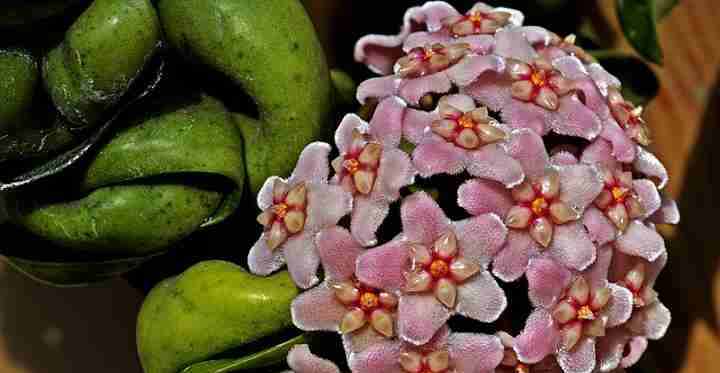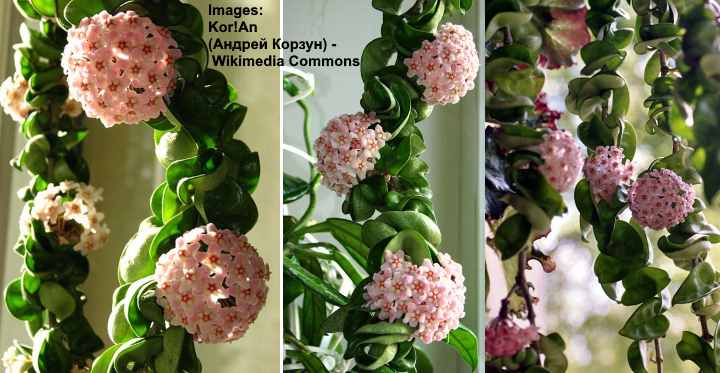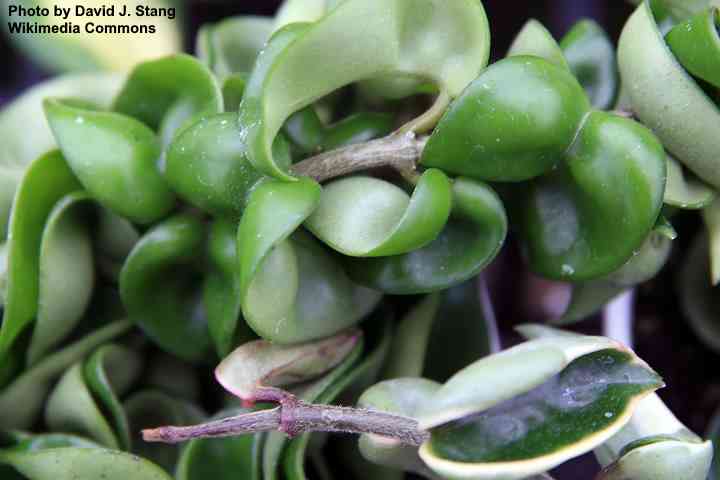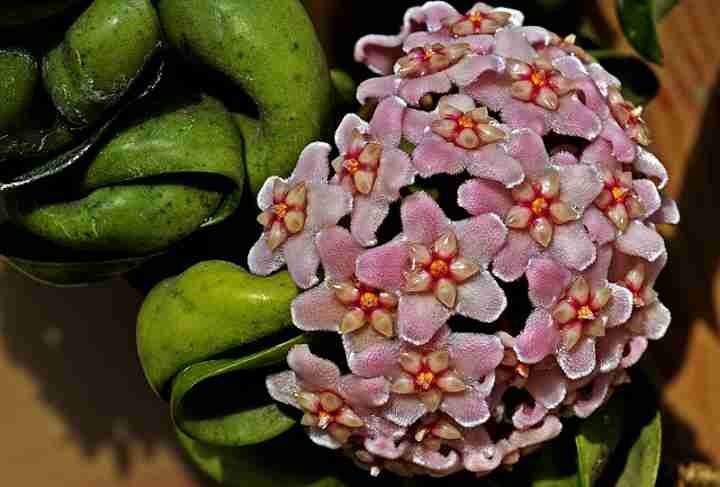Hindu Rope Plant (Hoya Carnosa Compacta): Ultimate Care Guide

The Hindu rope plant (Hoya carnosa compacta) is a type of succulent vine with dangling stems and thick waxy leaves. This tropical houseplant is also called the ‘Krinkle Kurl’ due to the twisted shape of the ‘curly’ leaves. Hoya rope plants belong to the family of wax plants that have porcelain-like flowers. From all the houseplants you can choose from, rope plants are some of the easiest to care for.
Hindu rope plants are species of wax vines in the family Apocynaceae. This rope plant is one of the 300 species of hoyas that are native to India, Asia, and Australia. In their native tropical rainforest environments, hoya rope plants thrive in warm, humid conditions. These flowering tropical plants also grow well indoors in average room temperature and humidity.
How to care for a Hindu rope plant: Your Hindu rope plant needs bright, indirect sunlight and well-draining, aerated soil. Water your hoya carnosa compacta plant only when the soil is partly dry. Rope plants grow in temperatures 60 and 80°F (16 – 27°C). Regular misting or a humidifier will keep moisture levels right.
When you get the care well for a Hindu rope plant, it will reward you with beautiful flowers in spring or summer. Flowers are usually star-shaped and white with pink centers. Clusters of these ‘porcelain’ flowers form an attractive dome-shaped flower head.
This article is a complete care guide for your Hoya carnosa compacta, or Hindu rope plant.
What is the Hindu Rope Plant (Hoya carnosa compacta)?

Hoya carnosa compacta is also called ‘Krinkle Kurl’ or Hindu rope plant
Hindu rope plants ‘Krinkle Kurl’ are draping succulents with long trailing stems. Leaves on the stems look like curled, twisted shapes. This evergreen wax plant looks stunning in a hanging basket or on a shelf. The dangling stems add a touch of nature to any bright room in your home.
Flowers grow on the end of stalks called peduncles. Balls of clustered white, pink, or purple flowers grace the draping stems when conditions are right. Plenty of bright light, getting enough nutrients, and proper watering help to ensure its flowers bloom every year.

The leaves of the Hindu rope plant are curled and twisted
Other types of rope plant
The Krinkle Kurl wax plant usually has dark green, succulent leaves that are contorted and curled. There are also other varieties of rope plants with variegated leaves and different colored flowers.
Hoya carnosa ‘Crispa.’ This type of waxy rope plant has dense, curled foliage and produces flowers in varying shades of red.
Hoya carnosa ‘Crispa Variegata.’ The tightly curled leaves are light green with golden yellow variegation.
Hoya carnosa ‘Regalis.’ This variegated rope plant has green and cream-colored flowers on its thick, curled wax leaves.
Hoya carnosa ‘Krimson Queen’. Hoya Krimson Queen is variegated hoya with thick waxy leaves, typically with three colors—pink, creamy-white and green variegation.
Other types of hoyas such as the tricolor hoya, Hoya curtisii, narrow-leaf hoya (H. kentiana), shooting stars (H. multiflora), and mini waxleaf hoya (H. lacunosa) are also trailing houseplants. The difference between these wax plants and rope hoyas is that they don’t have curly leaves.
Hindu Rope Plant Flowers

The hindu rope plant has star-shaped waxy flowers
Under the proper care conditions, rope plants produce pretty clusters of star-shaped flowers in the shape of a dome. Twenty or more small flowers make up the umbels— dome-shaped flower heads.
The waxy flowers can be shades of pink, red, yellow, orange, and white. The elegant white flowers are one reason why hoyas are also called porcelain flower plants.
How can you get your rope plant to bloom? The most crucial factor is plenty of bright indirect sunlight. It also may take a couple of years for your Hindu rope plant to start producing flowers.
How to Care for Your Hindu Rope Plant
Hindu rope plants are straightforward to care for. The most important things to get right are light, water, and soil.
Let’s look in more detail at the best way to care for any type of hoya rope plant.
Soil Requirements for Indian Rope Plant
The critical requirements for good rope plant soil are that it drains well and is light and airy. To get the soil right for Hindu rope plants, mix one-part regular potting mix, one-part orchid mix, and one-part perlite. Other suitable potting mediums for hoyas are sphagnum moss or orchid substrate.
Hoyas are evergreen plants that are classed as epiphytes. These types of tropical plants grow on the surface of other plants where their roots absorb nutrients from the air, water, and the host plant.
The most important thing to remember is not to allow your rope plant to sit in soggy soil or let it dry out. The potting mix should always partially dry out before you water it again. Another care tip for hoyas—and most other houseplants—is not to let them sit in water. Sitting in water causes the soil to become too moist, which leads to rotting roots and, ultimately, dead plants.
If you notice that the soil is squelchy and your hoya seems to be dying, you can try to revive it by repotting it. Later in the article, you will find out how to repot a hoya.
Light Requirements for Rope Plants (Hoya)
Place your rope hoya plant in a bright, sunny room where there is plenty of indirect sunshine. These succulents need around 6 hours of light daily. Bright light will also keep the leaves on tricolor variegated rope plants looking colorful and vibrant. The best rooms where Hindu rope plants grow are ones with west- or south-facing windows.
During the summer, you can grow your Hindu rope plants outside. As long as the temperature is well above 50°F (10°C) and the plant is in partial shade, your rope plant will thrive. An Indian rope plant can make a beautiful hanging basket on a summer patio, deck area, or balcony.
Proper care for your hoya rope plant should involve occasionally checking the health of the leaves. Too much sunlight can cause yellowing. If you notice this, move the houseplant away from direct sunlight. Also, rotate the plant every so often so that all sides get enough sunlight.
Species of Hoya carnosa compacta still grow well in medium to low-light conditions. However, they may not bloom if they don’t get enough light. However, rope plants are charming hanging plants for homes or offices.
Hindu Rope Plant Care: Watering Needs
Water rope plants whenever the top part of the soil has dried out. To water your hoya, pour enough water into the soil so that it drains out the bottom. Water your plant as often as the soil becomes partially dry. In summer, this could be as often as weekly.
The frequency of watering rope plants depends on air temperature and humidity levels. During the winter months, you should water less than in summer. So, always check that the top 1” (2.5 cm) of soil is dry before watering.
The best tip for watering a hoya is to water it less than it needs rather than more. So, don’t worry if you forget to water it once or twice. The succulent hoya vines are good at storing moisture. Their tolerance for dry conditions is one reason why rope plants are on the list of low-maintenance houseplants.
Temperature Requirements for Hindu Rope Plant
Average room temperatures are perfect for growing a hoya rope plants indoors. Ideally, temperatures should be above 60°F (16°C) and below 80°F (27°C). Proper hoya care also means protecting it from sudden temperature changes. Keep rope plants away from hot radiators or cold drafts.
The best way to know if the temperature is right for your rope plant is this—if you feel comfortable, your houseplants will feel good as well. In this regard, tropical Hindu rope plants are no exception.
If your hoya grows outdoor during the summer, bring it indoors when the nighttime temperature starts dropping below 60°F (16°C). The absolute minimum temperature for rope plants and other types of wax plants is 50°F (10°C).
Humidity Levels to Care for Indian Rope Plant
Tropical and subtropical houseplants such as hoyas need plenty of humidity. Regular household humidity is not enough for your Hindu rope plant to thrive. To boost moisture, you can mist the leaves daily, use a humidifier, or put your plant pot on a pebble tray with water.
The best way to know if your rope plant is needing more moisture is to check the succulent leaves. The wax leaves should be glossy and look healthy. If they look withered and dried, it’s time to bump up the humidity.
Other types of hoyas such as Hoya bilobata, Hoya kentiana, and Hoya carnosa ‘Rubra’ have thinner leaves and may require extra misting to keep them looking healthy.
To care for your Hindu rope plant during winter, you need to hold back with watering and increase humidity. Central heating tends to dry the air quicker, so you need to humidify it. Also, all types of hoyas grow slower in winter and need less care. So, as a rule of thumb, water it less and mist it more. This way you can prevent soil from becoming waterlogged or too damp.
Feeding Your Hanging Wax Plant
Similar to all species of hoyas, rope plants are slow-growing houseplants and don’t need a lot of feeding. Use an organic fertilizer for houseplants and apply every two or three weeks. Don’t fertilize hanging Hindu rope plants during winter or while they are flowering.
Hoya rope plants benefit from feeding during late spring and summer after they have finished blooming. Some houseplant enthusiasts recommend fertilizing with a phosphorus-rich fertilizer before your hoya flowers.
Just remember that too much fertilizer can damage the hoya plant’s root system. So, if you’re unsure about the amount of feeding your plant needs, care for your hoya by proper watering and giving it plenty of bright light.
Signs that you’ve over-fertilized a hoya are withered leaves, leaf drop, and white salts forming on the soil. If you think you’ve been too enthusiastic with feeding, flush the soil by pouring plenty of water through it. Allow it to drain out and hold off feeding for a few weeks. If flushing the soil doesn’t revive your rope plant, think about repotting the plant.
How to Prune Hindu Rope Plant
A Hoya carnosa compacta benefits from yearly pruning. In spring, cut back some of the leggy stems and remove any dead growth. This type of pruning helps your plant develop a bushy appearance and encourages healthy growth.
Take care when pruning a hoya rope plant because you don’t want to remove the peduncles. If you prune the flowering stems, you will delay flowering, and they may not bloom next season. These stems store a lot of energy that healthy hoyas need.
Remember always to use sterilized pruning shears to prevent spreading disease between plants.
Hindu Rope Plant Propagation
Using stem cuttings is the best way to propagate a healthy rope plant. Cut the stem at an angle, making sure there are at least two leaves on it. Place the end of the cutting in a jar that has some water. When roots start to appear, plant in a small pot.
After you have potted in good hoya potting mix, water it thoroughly.
If you have just pruned your hanging wax plant, you will have plenty of cuttings to use for propagation. The ideal type of cutting for hoya propagation should have two or three nodes on it with just two leaves at the top end of the cutting.
There is another method of propagating a Hindu rope plant. Dip the end of a fresh cutting in rooting hormone and plant in a small pot that contains hoya soil or cactus mix.
Repotting an Indian Rope Plant
Hoyas are so easy to care for that they rarely need repotting. Rope plants seem to thrive better when they are root-bound. At most, you only need to repot rope plants every two or three years. Transfer it to a larger pot 2” (5 cm) wider than its current one.
What are some of the signs you need to repot your Hindu rope plant? Usually, weak growth is a sign that the hoya is root bound too much. A mass of roots in the pot can prevent enough oxygen in the soil and the soil tends to get waterlogged. You may also notice that the potting mix dries out quickly after watering.
The best time to repot any species of hoya, including rope plants, is in spring or early summer. At this time, growth is vigorous, and repotting causes less stress to your plant.
To repot a hoya, carefully remove it from the pot and remove excess soil from the roots. Check for damaged or dead roots and prune them with sterilized pruning shears. Transfer to a new container that has fresh aerated potting mix.
The best type of pot for Hindu rope plants
The best kind of container for rope plants should have drainage holes in the bottom. Hanging baskets allow the long trailing stems with their curly waxy leaves to dangle elegantly.
Remember that soil in terracotta pots tends to dry out quicker than plastic containers. So, keep an eye on moisture levels to care well for your rope plant.
Common Rope Plant Pests
Hindu rope plants are hardy houseplants and are not prone to infestations and diseases. Small white fuzzy pests under the leaves are a sign of mealybugs. Scale and aphids can also affect rope plants and other varieties of hoyas.
Get rid of aphids by using an organic neem oil spray. Read this article to find out how to make your own natural pesticides.
Diseases that Affect Hindu Rope Plants
Fungal diseases can be a reason why leaves turn yellow on a hoya rope plant. The leading cause of fungal problems is over-watering. To revive a wilting or dying rope plant, you should try repotting it.
Old leaves also turn yellow before dropping off. If you occasionally have one or two yellow leaves, there is usually nothing to worry about—especially if you are watering your plants correctly.
Is the Hindu Rope Plant Toxic?
No. Rope plants are not poisonous for animals such as cats and dogs and don’t pose a threat to pets or humans.
Related articles:
